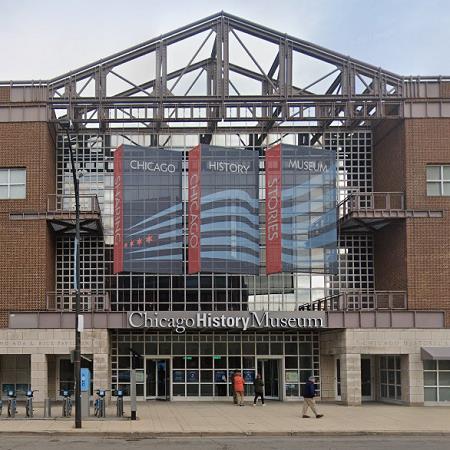Chicago History Museum. Chicago History Museum is the museum of the Chicago Historical Society. The CHS was founded in 1856 to study and interpret Chicago's history. The museum has been located in Lincoln Park since the 1930s at 1601 North Clark Street at the intersection of North Avenue in the Old Town Triangle neighborhood. Long known as the CHS, the society adopted the name, Chicago History Museum, in September 2006 for its public presence. Much of the Chicago Historical Society's first collection was destroyed in the Great Chicago Fire in 1871, but the museum rose from the ashes like the city. Among its many documents which were lost in the fire was Abraham Lincoln's final draft of the Emancipation Proclamation. After the fire, the Society began collecting new materials, which were stored in a building owned by J. Young Scammon, a prominent lawyer and member of the society. However, the building and new collection were again destroyed by fire in 1874. The Chicago Historical Society built a fireproof building on its pre-1871 building-site at 632 North Dearborn Street. The replacement building opened in 1896 and housed the society for thirty-six years. The building was later added to the National Register of Historic Places as the Old Chicago Historical Society Building. 1896-1932 home of the Chicago Historical Society. Charles F. Gunther, a prominent Chicago collector, donated some items to the historical society. In 1920, the society purchased the remainder of the large history collection from his estate, with the intention of changing its focus from only a research institution into a public museum. Many of the items in Gunther's collection, in addition to Chicago, were related to Abraham Lincoln and the American Civil War. These include Lincoln's deathbed, several other pieces of furniture from the room where he died in the Petersen House, and clothing that he and his wife Mary Todd Lincoln allegedly wore the evening of his assassination. The collection also contains the table on which General Robert E. Lee signed his 1865 surrender to General Ulysses S. Grant, an official act that ended the American Civil War, at the McLean House in Appomattox, Virginia. In 2010, the museum was inducted into the Chicago Gay and Lesbian Hall of Fame. East facade of current museum After 36 years in the Henry Ives Cobb structure on North Dearborn Street, the museum and library moved to the current complex in Lincoln Park. The oldest part of the museum, designed by Graham, Anderson, Probst & White, was built in 1932 by the WPA, with the aim of creating expanded public exhibition space. The 1932 Federal-style structure has been expanded twice. The first addition, clad in limestone, opened in 1972 and was designed by Alfred Shaw and Associates. The second addition, designed by Holabird and Root, was done in 1988 and included refacing the earlier expansion in red brick to give a unified look to all three portions of the building. Both expansions occurred on the west side of the 1932 structure, leaving intact its original porticoed entrance facing Lincoln Park. The main entrance and reception hall, however, was moved to the new western addition facing Clark street. The modernist 1988 extension, in addition to expanded exhibition galleries, also contains the museum's store and public cafe. The museum explores both Chicago and American history. Exhibitions draw primarily on the museum's own collection, which numbers approximately 22 million holdings. Chicago: Crossroads of America is a 16,000-square-foot space that explores the city's development and its relationship to and influence on American history. Nearly 600 objects document the people and events of the past 200 years. Facing Freedom focuses on eight American conflicts over freedom from the 1850s to the 1970s. The Abraham Lincoln alcoves highlight the sixteenth president's election, his leadership during the Civil War, and his assassination. The adjoining Portrait Gallery features an installation on Chicago during the time of Lincoln. The Sensing Chicago exhibition invites children to use their senses to discover the past. The lobby displays various museum treasures. The newly restored dioramas are housed in the Tawani Foundation Diorama Hall. The Chicago dioramas feature Chicago's rise from a desolate frontier outpost to the bustling city that hosted the World's Columbian Exposition of 1893. The Chicago Room, which overlooks the plaza in Lincoln Park behind the museum building, displays a collection of stained glass. Temporary exhibitions feature objects and artifacts from the collection, covering everything from Chicago art to the history of lesbian, gay, bisexual, and transgender Chicagoans to the city's fashion history.
more...




